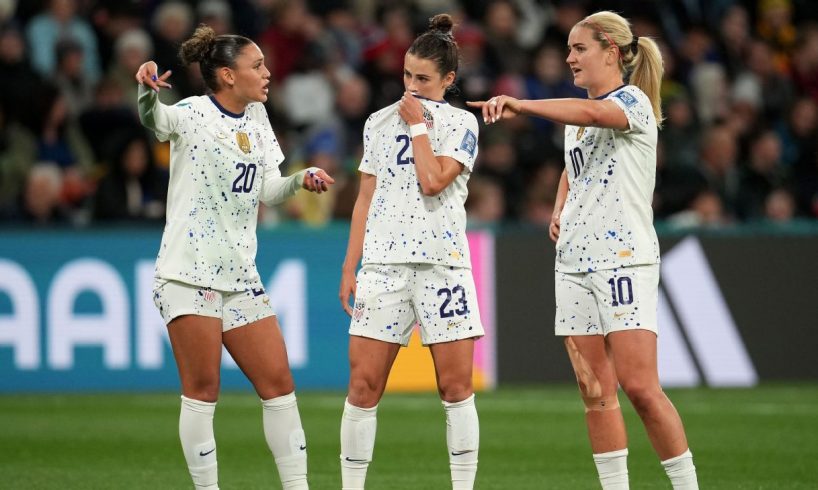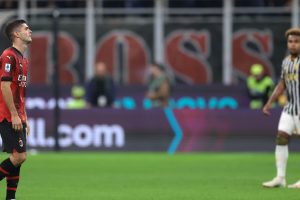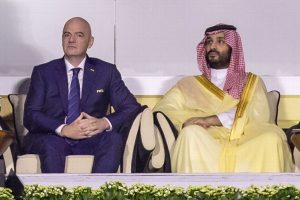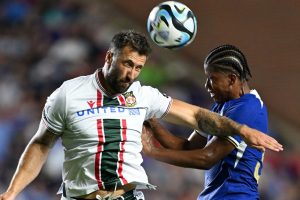
Nov 20, 2023, 10:17 AM ET
Emma Hayes knows more about soccer than you. There’s no shame in it — she knows way more about soccer than me, too. She’s been coaching one of the best women’s teams in the world for more than a decade. She’s won trophies — six English league titles among the batch. She’s coached on multiple continents. She’s been a studio analyst for ESPN, and she’s also written about the sport as a columnist for The Telegraph.
Now, that last bit makes me even more grateful that U.S. Soccer made Hayes its top choice to replace Vlatko Andonovski as the new coach of the U.S. women’s national team. At least Hayes isn’t coming for my job just yet.
So yes, Hayes knows a lot about soccer. But she doesn’t yet know how this transition from coaching Chelsea to coaching the U.S. on the international stage will go.
The logistics of Hayes shifting from Chelsea to the USWNT are complicated. She’s going to finish Chelsea’s season in England before taking over full time with the United States early next summer. That in-between period isn’t ideal for the U.S but it does present Hayes with time to sort through her first steps in a new role.
What should she prioritize on her USWNT to-do list? Using Hayes’ own background and some of Andonovski’s missteps as a guide, let’s take a look.
– Stream on ESPN+: LaLiga, Bundesliga, more (U.S.)
1. Fully scout the player pool
Getting extremely familiar with all of your new players is a no-brainer start point for any new coach taking over a new team. After all, players drive success, and coaches influence that success by placing their players in the best possible situations.
Editor’s Picks
2 Related
For Hayes, digging into the player pool is even more firmly fixed at the top of her priorities list. Why? Well, because she can work-from-home her way through this one. It’s 2023, folks, and soccer coaches can tap into the benefits of working from home just like many of the rest of us. Hayes will still be across the Atlantic in London for most of the next few months, but she’ll have access to tools like Wyscout and plenty of other film and data to get up to speed on her players’ tendencies, strengths, and weaknesses.
She already knows a few of the United States’ players from coaching them with Chelsea — think Crystal Dunn, Mia Fishel, and Catarina Macario. She’s clearly observed the team from afar during major tournaments, too, and I’d be shocked if she didn’t come into her interview process with U.S. Soccer with a high level of knowledge about the American player pool. Those things give Hayes a head start.
But now is the time to learn everything there is to learn about Sophia Smith’s off-ball movement. And Naomi Girma’s distribution. And Katie Lund’s shot-stopping in the NWSL. And … well, you get the idea.
2. Start phasing out some of the 2023 World Cup squad
Andonovski had it good after the World Cup. Sure, he resigned after what ended up being a major failure in Australia and New Zealand. But in doing so, he escaped what might be the worst part of being a coach: having to move on.
Calling players to tell them that they’re not in your plans or that they’re not in the squad for the next camp is an awkward process.From left to right, Trinity Rodman, Emily Fox and Lindsey Horan have a discussion during the USWNT’s round-of-16 World Cup match against Sweden in August. Brad Smith/Getty Images for USSF
Whether it’s Hayes making decisions through Kilgore for the next few international windows (I told you the logistics were complicated!) or Hayes picking up the phone herself, now is the time to start phasing out a handful of U.S. players.
Alyssa Naeher, who started for the USWNT at the World Cup and has continued to get call-ups and starts since that tournament, is a prime example. Now 35, Naeher allowed more goals than expected than any other goalkeeper in the NWSL last season. According to American Soccer Analysis, she conceded 7.49 more goals than expected, while Lund saved 5.39 more than expected.
Alex Morgan, another World Cup starter, is now far from being the U.S.’s best option up front. Comparing Morgan to Smith based on this most recent NWSL season where they both played as lone strikers, Smith:
More than doubled Morgan’s scoring rate per 90 minutes (0.85 goals vs. 0.41 goals, per FBref)
Recorded more non-penalty expected goals per 90 minutes (0.55 for Smith, 0.39 for Morgan, per FBref)
Roster spots and minutes that have previously gone to defensive midfielder Andi Sullivan (27), midfielder/defender Emily Sonnett (29), and No. 8 Kristie Mewis (32) might be better spent elsewhere, too.
Coming in fresh, Hayes shouldn’t have the same attachment to these players that Andonovski did. That should help spur change despite Hayes being an ocean away.
3. Start integrating the youth
There’s always a temptation to gravitate toward the new, shiny, fun thing, even if it’s not the best thing at any given moment. For Hayes, though, moving toward the United States’ next generation is both the fun thing to do and the best thing to do. Some of the USWNT’s top creative players also happen to be some of their youngest players.
As Hayes noted during the World Cup, the U.S. needs playmakers.
“I think America are massively short of creative talent,” she wrote for The Telegraph. “When you’re playing against more well-organised teams, better-coached teams, you have to break them down, and that breaking teams down is a combination of strategy, tactics and personnel, and I don’t see that they’ve got the personnel to do that.”
play
0:36
Purce: Hayes knows exactly what she needs to do with the USWNT
Midge Purce speaks about Emma Hayes’ appointment as head coach of the USWNT.
A few months after the World Cup and a couple of thousand minutes into the professional careers for a pair of young stars, Hayes has a chance to address her own observation.
Teenage San Diego Wave attacker Jaedyn Shaw completed almost twice as many through balls as any other player in the NWSL in 2023 (20, Savannah McCaskill finished second with 11). At 18, Shaw can spot passes that few other players in the world can. The Portland Thorns’ Olivia Moultrie, also 18, finished in the 99th percentile for expected assisted goals among NWSL midfielders in 2023, per FBref. Both players have been in camps with the U.S. since the World Cup, but neither has played a big role.
Hayes will make her life much easier by finding opportunities for Shaw and Moultrie.
4. Prepare the USWNT’s tactical approach
If you’ve spent a minute or two reading about Hayes’ tactical approach with Chelsea, you already know that she’s a chameleon. Based on personnel and the opponent, Hayes has historically been willing to adjust her team’s shape and attacking game plan. As an example, Chelsea averaged 59.3% possession in the WSL last year. Across eight total Champions League games against Barcelona, PSG, Lyon, and Real Madrid, Chelsea averaged just 46.6% possession.
STREAM FUTBOL AMERICAS ON ESPN+
Herculez Gomez and Sebastian Salazar debate the biggest storylines and break down the best highlights that soccer in the Americas has to offer. Stream on ESPN+ (U.S. only)
With the USWNT, Hayes will have more time to prepare specific approaches for specific opponents than she does with Chelsea — she can thank the relatively light international calendar for that. Extra time to plan is good news for the part of Hayes’ psyche that exhibits her eccentric tactical tendencies. It’s bad news, however, for her practical side. Instead of working on strategic twists with her players on the training ground almost every day, Hayes will have only a few days here and there with the team outside of major tournaments.
Hayes can still vary her team’s game plan in a new environment, but doing so will require a little creativity. She’ll have to communicate the most important information to her players in a smaller amount of time than she’s used to, which is a transition that Andonovski seemed to struggle with as he moved from club to country. Building strategic pillars for the United States based on the kinds of teams that the U.S. face would be a step in the right direction.
There are four main types of teams that the USWNT comes across:
1. Bad teams (think Vietnam at the World Cup)
2. Good teams that don’t like the ball (think Sweden)
3. Good teams that do like the ball (think Spain)
4. Good teams that are somewhere in the middle (think England)
If Hayes can develop default approaches for when the U.S. clashes with teams in each of those buckets and communicate them clearly, players will have a strong tactical foundation coming into each camp.
5. Spend extra time in the final third
One of the banes of the USWNT’s existence for years has been playing against teams that set up with a low block. To be fair, that’s not unique to the United States: breaking down a low block is the hardest thing to do in soccer because space is at a premium with a host of defenders back protecting the goal.
But under Andonovski, the United States really struggled against low blocks. They lacked diverse ideas and execution in order to create chances against set defenses. Hayes seemed to pile the lion’s share of the blame for that issue on the U.S.’s lack of creative players during the World Cup, but she took care to include in one of her columns that “breaking teams down is a combination of strategy, tactics and personnel.” There’s an undeniable strategic element to breaking down a low block, one that Hayes must take care to develop and train into her players — at least more than Andonovski.
The U.S. defaulted to sluggish possession and crosses from wide areas in that last tournament cycle. At the 2023 World Cup, the U.S. crossed the ball on over 6% of their passes, per FBref. That was more than any other team at the tournament, while only one other squad passed the 5% mark (France). The U.S. scored just one goal outside of its opener against Vietnam before losing in the round of 16. The World Cup is a tiny sample, but similar issues popped up at the Tokyo Olympics and in virtually every U.S. game between the two competitions.
So, there’s tactical work to be done for the U.S. in the final third to avoid basic mistakes like poor spacing and slow ball movement that have plagued the Americans in the past. Hayes isn’t likely to reinvent the wheel in the final third, especially since her Chelsea team doesn’t use many detailed patterns against low blocks. But adding more clarity and a little more variety will go a long way for the United States.






